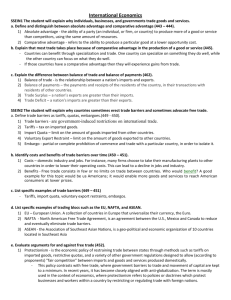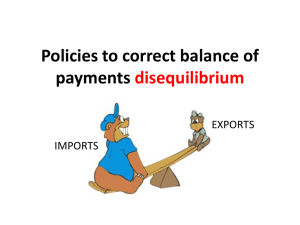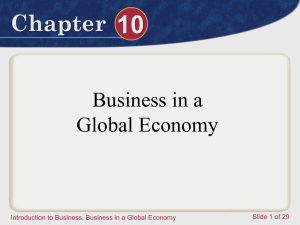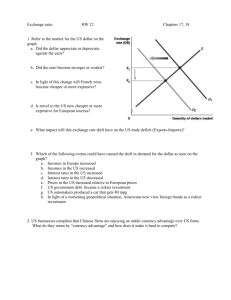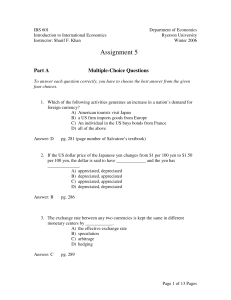Notes for Chapter 17 - FIU Faculty Websites
advertisement
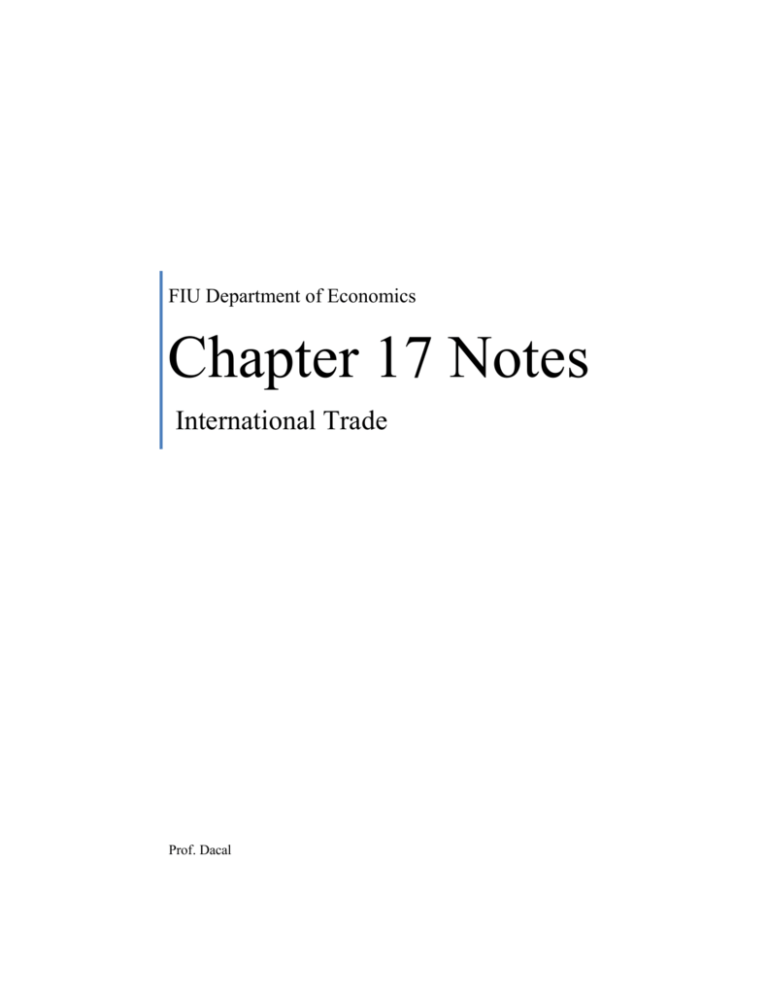
FIU Department of Economics Chapter 17 Notes International Trade Prof. Dacal Chapter 17 Notes I. U.S. Trade Patterns Imports Imports are goods and services purchased from foreign sources. We buy over 2 trillion worth of goods and services to the rest of the world. Exports Exports are goods and services sold to foreign buyers. We sell over 1 trillion worth of goods and services to the rest of the world. Trade Balance The trade balances is computed by: Trade balance = Exports – Imports Trade deficit is the amount by which the value of imports exceeds the value of exports in a given time period. In merchandises the US has a large deficit due to oil and auto imports. In services it enjoys a modest surplus. Trade surplus is the amount by which the value of exports exceeds the value of imports in a given time period. On a global scale, imports must equal export. For every dollar going to deficit for a given country, there must be a surplus of equal amount globally. 2 Chapter 17 Notes Einstein’s law of relativity can be applied in the context of global trade, For every action there is an equal and opposite reaction. In the context of global trade, for every dollar in imported there has to be one dollar in export With respect to the US trade deficit, in the long run the US dollar will become too weak or foreign investors will not lend to us. II. Motivation to Trade The gain from trade will be increased world output and thus a higher standard of living in the countries that participate in trade. Specialization, in the context of international trade, is “a method of production where a business or area focuses on the production of a limited scope of products or services in order to gain greater degrees of productive efficiency within the entire system of businesses or areas. Many countries specialize in producing the goods and services”1 were the country has competitive advantage. Production and Consumption without trade Production possibility is the alternative combinations of goods and services that could be produced in a given time period with all available resources and technology. Look at page 361 graphs (It shows the constant production possibility frontier of two trading countries) Consumption possibilities is the alternative combinations of goods and services that a country could consume in a given time period. If the country does not trade, 1 The production possibility frontier curve defines the limits to what a country can produce. The consumers within that economy will only have the products produced within their country to consume (consumption possibility). (Inverstopedia ULC) 3 Chapter 17 Notes When a nation specialize in production; The quantity of consumption increases. The amounts of goods and services provided for consumption increase (mix). Trade increases Specialization and World Output. If you are good at producing a particular product, and it cost you less than anyone else you will produce this product for the rest of the world. Better profit margins Higher profits, and More output. When we specialize, we are able to produce more of the produce and therefore the combined output of countries conducting trade will have standard of living gains. The gains from trade are [mainly] due to specialization in production. III. Comparative Advantage Opportunity cost is the most desired foods or services that are forgone in order to btain something else. Comparative advantage is the ability of a country to produce a specific good at a lower opportunity cost than its trading partners. Comparative advantage refers to the relative cost of producing particular goods. World output, and thus the potential gains from trade, will be maximized when each country pursues its comparative advantage. A firm’s linear PPF implies that a reallocation of resources from one activity to another faces constant opportunity cost. What is Tom’s Opportunity Cost of producing one bottle? If Tom has 1333 of water and zero bottles, Tom must give up 333 of water for one bottle, or 333/1000 = .333 4 Chapter 17 Notes What is Tom’s opportunity cost of producing one unit of water? If Tom has 4000 of bottles and zero of water, Tom must give up 3000 unit of bottles for 1000 units of water, or 3000/1000 = 3 Tom has a competitive advantage in producing bottles (.333 < 3). For Nancy her opportunity cost of producing one unit of waters is .333 bottles, and her opportunity cost for one bottle is 3 units of water. Nancy has a competitive advantage in producing water (.333 < 3). If they both produce water and bottles the most that they could produce is 1000 of both each. So the total gain for the economy is 2000 bottles of water. Achieving the Gains from Trade If Tom produces 4000 bottles and Nancy produces 4000 units of water, then we gain 4000-2000 more bottles of water. That is why we gain from trade!!!! Absolute Cost don’t Count Absolute advantage – is the ability of a country to produce a specific good with fewer resources than other countries. When one person is more productive than another person in several or even all activities implies absolute advantage. When one has absolute advantage it does not mean that the person has competitive advantage. IV. Terms of Trade Terms of trade is the rate at which goods and services are exchanged; the amount of good A given up for good B in trade. This helps us determine how much goods and services we need to export and how many we need to import. 5 Chapter 17 Notes Limits to the Term of Trade A country will not trade unless the terms of trade are superior to domestic opportunity cost. The terms of trade between any two countries will lie somewhere between their respective opportunity costs in production Loaf of bread will be at least ½ barrel of wine (US OC) Loaf of bread will be no more than 4 barrels of wine (France’s OC) The Market Mechanism The forces in the market are derived by entrepreneurs who are trying to make a buck. They see divergence in the prices of the product They see an opportunity to expand the markets Once transactions start, secondary players will change the production behavior (example wheat farmer in France becomes a grape farmer). The abundant supply of cheaper products increases the amount of products our paychecks can afford, thus increasing the consumption. The terms of trade, like the price of any food, will depend on the willingness of market participants to buy or sell at various prices. V. Protectionist Pressures Some reasons for protectionalism Import substitution industrialization (Latin America’s Economy: Diversity, Trends and Conflicts. Cardoso and Helwege). Workers and producers who compete with imported products –who work in import-competing industries – have an economic interest in restricting trade Trade not only alters the mix of output but also redistributes income from importcompeting industries to export industries. 6 Chapter 17 Notes VI. Barriers to Trade Tariffs Tariffs are a tax (duty) imposed on imported goods. The tariff on imported goods makes them more expensive to domestic consumers and thus less competitive with domestically produced goods. Quotas Quota is a limit on the quantity of a good tat may be imported in a given time period. Quotas are a much greater threat to competition than tariffs, because quotas preclude additional imports at any price. Exchange Rate Exchange rate is the price of one country’s currency express in term of another country’s currency. Pf Pd Pd Pf €/¥ this is the exchange for euros to yen (Euro per yen). Denoted as: or £/¥ this is the exchange for pound to yen (pound per yen). $/¥ this is the exchange for pound to yen (dollar per yen). So long as each nation has its own currency, every trade will require use of two different currencies at some point. Global pricing The dollar price of imported good = (price of good) × (exchange rate) ‘Exchange rate’ is the dollar price of foreign currency. 7 Chapter 17 Notes Appreciation / Depreciation Whenever exchange rates change, so does the global price of all imports and exports. Currency appreciation is an increase in the value of one currency relative to another Currency depreciation is a decrease in the value of one currency relative to another Again, Einstein’s law of relativity does apply. If one country’s currency is appreciating, another country’s currency is depresiating If the value of a nation’s currency declines, Its exports become cheaper. Its imports become more expensive. Foreign Exchange Market An exchange rate is the price of a currency, and it is determine by the forces of supply and demand. Exchange rates change when either the supply or the demand for currency shifts (think gold standard). 8

